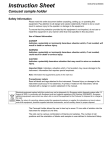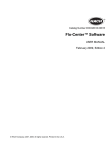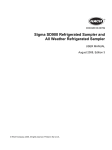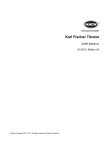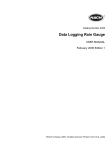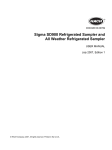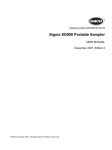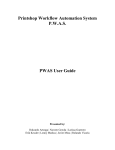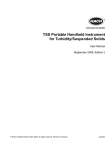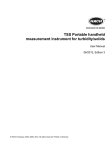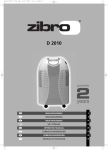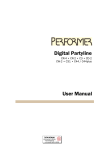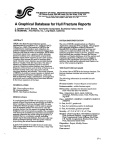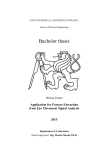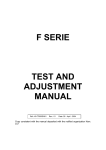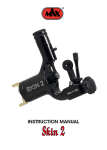Download "user manual"
Transcript
Instruction Sheet DOC276.53.90025 Universal junction box (4-20 mA input) Safety information Please read this entire document before unpacking, setting up, or operating this equipment. Pay attention to all danger, warning, and caution statements. Failure to do so could result in serious injury to the operator or damage to the equipment. Make sure that the protection provided by this equipment is not impaired, do not use or install this equipment in any manner other than that specified in this document. Important Note: Indicates a situation which, if not avoided, may cause damage to the instrument. Information that requires special emphasis. WARNING Indicates a potentially or imminently hazardous situation which, if not avoided, could result in death or serious injury. Note: Information that supplements points in the main text. Precautionary Labels Read all labels and tags attached to the instrument. Personal injury or damage to the instrument could occur if not observed. A symbol, if noted on the instrument, will be included with a danger or caution statement in the manual. Electrical equipment marked with this symbol may not be disposed of in European public disposal systems after 12 August of 2005. In conformity with European local and national regulations (EU Directive 2002/96/EC), European electrical equipment users must now return old or end-of life equipment to the Producer for disposal at no charge to the user. Note: For return for recycling, please contact the equipment producer or supplier for instructions on how to return end-of-life equipment, producer-supplied electrical accessories, and all auxiliary items for proper disposal. Overview WARNING Possible Explosion Hazard. The sampler connection is not applicable for a direct connection to flow meters classified for use in hazardous locations without approved barriers. If the connection is to a flow meter that is classified for, and used in, a hazardous location, refer to the flow meter control drawing for connection requirements. Universal Junction Box The universal junction box (8760600) gives the necessary interface between an external flow meter or other device with applicable pulse or current output and the SD900 controller. This instruction sheet gives: • The steps to prepare and connect a universal junction box to a SD900 controller with a 4–20 mA input and to a device with a 4–20 mA output. These connections are required for flow proportional sampling. • The necessary steps to configure the SD900 controller for flow proportional sampling using the 4–20 mA input. 1 Universal junction box (4-20 mA input) SD900 4–20 mA input Pin C of the SD900 controller auxiliary interface can be used as an external pulse input or as a 4–20 mA input. An external flow meter (such as a Sigma 950) can be connected to this input for flow proportional sampling. Note: The 4–20 mA output connector on the Sigma 950 flow meter is a factory installed option (2676) and comes with a 25 ft. output cable (2924). The SD900 4–20 mA input removes the need for a separate 2021 or 2020 4–20 mA interface in flow proportional sampling applications. Important Note: Do not connect a flow meter that outputs flow pulses on the SD900 auxiliary interface when the sampler is configured for 4–20 mA input. Pulse Mode Flow proportional sampling requires an external device with applicable pulse or current output such as a Sigma 950 flow meter. In pulse mode, each pulse or contact closure supplied by the external device represents the measurement of a specifed flow-volume. These signals occur more frequently at higher flow rates and less frequently at lower flow rates. Numerical scaling is set in the SD900 FLOW SOURCE menu below PROGRAM SETUP. The SD900 can collect between 1 and 9,999 pulses or closures. Current Mode In current mode, a flow meter or external device outputs a current value between 4 and 20 mA to the 4–20 mA input of the SD900. (The current input range for the SD900 is 4–20 mA). The 4–20 mA output is proportional to the measured flow rate. Higher current values represent higher flow rates and lower current values represent lower flow rates. The numerical scaling that defines the relationship between the 4–20 mA value and the flow rate must be programmed the same in both the SD900 and the external flow measurement device. Numerical scaling is set in the FLOW SOURCE menu under PROGRAM SETUP in the SD900 controller (see Controller set up for 4–20 mA input on page 9). The sampler calculates a flow rate based on the pulse or current inputs. In either mode, the sampler integrates the flow rate over time to determine an aggregate flow volume. Samples are taken at programmable increments of aggregate flow. Important Note: The 4–20 mA option should only be used when an AC power supply is installed on the flow meter and the SD900. Battery power is not sufficient to support the 4–20 mA current loop power requirements. Universal junction box Dimensions Figure 1 shows the dimensions of the Universal Junction Box. 2 Universal junction box (4-20 mA input) Figure 1 Universal junction box dimensions Universal junction box wiring Important Note: For safety, the universal junction box contains a replaceable 5 mm x20 mm fast-acting fuse (6681000) on the sampler Auxiliary Port line (Pin A). This fuse is rated at 0.25 A, 250 V and is manufactured by Cooper Bussman (p/n S500-250mA). Do not rewire the junction box to bypass this fuse. To wire the universal junction box, complete these steps: 1. Strip 1.5 inches off the customer-supplied cable jacket (Figure 2 on page 4). 2. Strip off 0.2 inches from each cable wire (Figure 2 on page 4). 3 Universal junction box (4-20 mA input) Figure 2 Prepare the wire Note: An extra liquid fitting (8783000) can be included when a smaller cable is used. 3. Remove the lid from the universal junction box with a Philips head screw driver. 4. Put the cable through the strain relief. 5. Use Figure 3 and Table 1 to find which terminals to use. For connection to a Sigma 950 flow meter refer to Figure 4. Figure 3 Universal junction box interior 1 Universal junction box output cable 2 Fuse holder 3 Wiring terminals (refer to Table 1) Table 1 Terminal assignments 4 Terminal No. Assignment Terminal No. Assignment 1 Fuse 5 Inhibit 2 Power 6 Output 3 Common 7 Complete 4 Input 8 Shield Universal junction box (4-20 mA input) Figure 4 Terminal wiring for 950 flow meter 1 To SD900 controller auxiliary connector 3 Output A - (negative) black OR Output B - (negative) green 2 4–20 mA output cable assembly (2924) 4 Output A + (positive) yellow OR Output B + (positive) red 6. Put the wires in the correct terminals and tighten. 7. Tighten the strain relief on the cable. Do not twist the cable leads. 8. OPTIONAL STEP: Apply the gel potting included with the universal junction box kit to the inside of the universal junction box to help prevent vibration effects. The gel is not necessary for junction box installation or use. To apply the gel, complete the steps below: a. Twist the static mixer on the gel cartridge. b. Dispense the gel by using the hand plunger. c. Discard the first quantity that was dispensed by the static mixer, otherwise it will not mix correctly. d. With the junction box flat on a horizontal surface, empty the two gel cartridges into the junction box until it is filled. Let the gel set for five minutes. 9. Replace the junction box lid and tighten the screws. 5 Universal junction box (4-20 mA input) Wiring information for non-Sigma flow meters Use the information in Table 2 to wire the universal junction box for connection to non-Sigma flow meters. Table 2 Wiring description for non-Sigma flow meters Terminal 2 3 Signal description Purpose 12 VDC power output Power supply positive output. Must be used in conjunction with pin B (common). Common Power supply negative return. When using AC power, this pin is connected to earth ground. This input triggers sample collection. The signal may be generated by: 4 5 6 Pulse/Current input Liquid level actuator/auxili ary control input • An external flow meter or other device with an appropriate pulse or 4–20 mA control output. • Simple floating (dry) contact closure. • An external flow meter or other device with a 4–20 mA control output. This input sends a signal to the microprocessor inside the sampler causing it to "wake up" and begin or resume its sampling program. Applications for this input include: A simple float level switch (dry contacts) may be used to actuate the sampler when liquid is present. Start this sampler after another sampler has finished its program. Start the sampler in response to some user-defined condition from an external device that provides an appropriate control signal. For example a pH meter could be used to initiate sampling in response to a high or low pH condition. Rating This output is protected by a 250 mA fuse. In pulse mode, this input responds to a positive pulse with respect to Common (pin B). It is terminated (pulled low) to Common (pin B) through a series 1 kΩ resistor and 7.5 V zener diode. In current mode, the input responds to current entering pin C and returning on pin B (common). The input burden is 100 ohms plus 0.4 V. The maximum input current is internally limited at 40 to 50 mA, but long term operation in this state constitutes abuse and is not warranted. Absolute maximum input: 0 to 15 VDC with respect to Common (pin B). Signal required to activate input: 5–15 V positive going pulse with respect to common (pin B) of at least 50 millisecond duration. Source impedance of driving signal should be less than 5 kΩ. Dry contact (switch) closure of at least 50 millisecond duration between pin A (12 VDC) and pin C (Pulse Input). Contact resistance should be less than 5 kΩ. Contact current will be less than 8 mA DC. This input is terminated (pulled high) to an internal +5 V supply through an 11 kΩ resistance and protected by a series 1 kΩ resistor and 7.5 V zener diode terminated to Common (pin B). The input responds to a high to low voltage transition with a logic low pulse width of at least 50 milliseconds. Absolute maximum input: 0 to 15 VDC with respect to Common (pin B). Signal required to activate input: External logic signal having 5-15 VDC power source. The drive signal should be normally high. The external driver should be capable of sinking 0.5 mA @ 1 VDC maximum at the logic low level. A logic high signal from a driver with power source of greater than 7.5 V will source current into this input at the rate of: I = (V - 7.5)/1000 where: I is the source current V is the power supply voltage of the driving logic. Dry contact (switch) closure of at least 50 millisecond duration between pin D and pin B (common). Contact resistance should be less than 2 kΩ. Contact current will be less than 0.5 mA DC. Universal junction box (4-20 mA input) Table 2 Wiring description for non-Sigma flow meters (continued) Terminal 6 7 8 Signal description Purpose Rating Event output Normally at 0 VDC, this line goes to +12 VDC upon any of the selected events described in Section 5.3.2 of the SD900 Portable Sampler User Manual. This output is thermally protected against short circuit currents to common (pin B). Limit external load current to 0.2 A. The output is normally logic low (0 VDC) with respect to common (pin B). Active high output levels are: 15 VDC nominal when using AC power to power the sampler 12 VDC nominal when using battery 8754400 to power the sampler. Program complete output Normally an open circuit, this line switches to ground for 90 seconds at the conclusion of the sampling program. Used to “wake up” another sampler to take over sampling or to signal an operator or data logger upon the completion of the sampling program. This pin is also used to signal the bottle full condition in a single bottle/continuous mode, and will transmit the bottle number to a flow meter if the program complete signal is disabled. This is an open collector output with 18 V zener clamp diode for overvoltage protection. The output is active low with respect to common (pin B). Absolute maximum ratings for output transistor: Sink current = 25 mA DC maximum. External pull-up voltage = 18 VDC maximum. Provides connection to earth ground when the sampler is powered using AC power. This connection is only intended for use in controlling RF emissions and susceptibility. Not intended for use as safety ground. Do not use as a current carrying conductor. Cables greater than 3 meters length connected to the sampler auxiliary port should be shielded. Regardless of length, if a shielded cable is connected to the auxiliary port, the shield (drain) wire should only be connected to earth ground at one end of the cable to avoid ground loop currents. Shield 7 Universal junction box (4-20 mA input) Connect an external 4–20 mA transmitter Most self-powered 4–20 mA transmitters have two terminals that float relative to ground. Connect the transmitter output (+) terminal to the sampler pulse current input (pin 4 of the universal junction box). Connect the transmitter return (-) terminal to the Common terminal (pin 3 of the universal junction box). Refer to Figure 5 and Table 3. Figure 5 Junction box connection for self-powered transmitter 1 Universal junction box 2 Wiring terminals (see Table 3) 3 External transmitter Table 3 Terminal assignments Terminal No. Assignment 3 Common 4 Input Some 4–20 mA transmitters require an external power source. The transmitter is then connected between the power output (+) and the sampler pulse current input (pin 4). To provide a complete current path, the power return (-) terminal must be connected to the sampler Common (pin 3). Refer to Figure 6 and Table 4. Figure 6 Junction box connection for external powered transmitter 1 Universal junction box 2 Wiring terminals (refer to Table 4) 3 External transmitter Table 4 Terminal assignments Terminal No. Assignment 3 Common 4 Input If the transmitter requires an external power source but none is available, power may be taken from the sampler Auxiliary port (pin 2). However, this may shorten battery life. Refer to Figure 7 and Table 5. 8 Universal junction box (4-20 mA input) Figure 7 Junction box connection for SD900 powered transmitter 1 Universal junction box 2 Wiring terminals (refer to Table 5) 3 External transmitter Table 5 Terminal assignments Terminal No. Assignment 2 Power 3 Common (No connection) 4 Input Controller set up for 4–20 mA input Controller set up considerations: • VARIABLE INTERVALS feature cannot be enabled while pacing using the 4–20 mA input. • PROGRAM DELAY using TIME/DATE can be used but PROGRAM DELAY using COUNTS is not allowed when using the 4–20 mA input. • If the user has configured PROGRAM DELAY using COUNTS, the PROGRAM DELAY is disabled upon selecting the 4–20 mA input as a flow source. • OVERRIDE TIME is reset to zero after every sample draw. To enable flow proportional sampling using 4–20 mA input on the SD900 controller, complete the steps below: 1. From the Main Menu, Select PROGRAM SETUP, MODIFY SELECTED, SAMPLE PACING, FLOW BASED. 2. Select 4–20 mA INPUT as the flow source. 3. Select the units used to specify the flow rate while mapping the 4mA and 20mA inputs. 9 Universal junction box (4-20 mA input) 4. Enter the flow rate for the 4mA input. 5. Enter the flow rate for the 20mA input. 6. Specify the total flow volume after which the sample should be drawn. 7. Enable or disable the override time.This is the time after a sample will be drawn even if the accumulated flow has not reached the total specified in step 6. 8. Specify the override time (if enabled). 4–20 mA Diagnostic Screen This screen can be used to: • view the current value read by the SD900 controller from the 4–20 mA current loop. • view the calculated flow rate based on the current value and the 4–20 mA mapping provided by the user. From the Main Menu, select DIAGNOSTICS, 4–20 mA INPUT. The display shows the input current value and calculated flow rate. Example of flow proportional sampling using the SD900 4–20 mA option The following example illustrates flow proportional sampling. A Sigma 950 flow meter with a 4–20 mA output is connected to the 4–20 mA input on a SD900 through a universal junction box (Figure 8). 1. Connect the 4–20 mA output of the Sigma 950 to the 4–20 mA input of the SD900. This forms a current loop. 2. Assume the Sigma 950 is configured to use a V-notch weir at 30 degrees as the primary device. Configure the 4–20 mA output on the Sigma 950. Set the input channel as FLOW and map the 4mA output to 9.48 gpm and the 20mA output to 1716 gpm. If the device senses a level of 12 inches, the corresponding flow is 300 gpm. 10 Universal junction box (4-20 mA input) 3. Press RUN/STOP to start the program. 4. Configure the SD900 for 4–20 mA. Set the flow source as the 4–20 mA input. 5. Select the flow units as gpm. 6. Enter 9.48 gpm as the 4mA and 1716 gpm as the 20mA. 7. Below TAKE EVERY SAMPLE, enter 1500 gal. as the total flow value. 8. Configure the remaining parameters and press RUN/HALT PROGRAM and START the program. A sample will be drawn every 5 minutes. Note: This result assumes that the 950 senses a steady level of 12 inches and that an override time of less than 5 minutes has not been specified. Figure 8 SD900 to Sigma 950 connection 1 SD900 Auxiliary connector 4 Sigma 950 flow meter 2 SD900 controller 5 4–20 mA output cable (2924) 3 Sigma 950 4–20 mA output connector 6 Universal junction box 11 Contact Information Repair Service in the United States: Authorization must be obtained before sending any items for repair. HACH Company Tel 1 (800) 635-1230 or (970) 669-3050 Fax (970) 461-3924 [email protected] Canada, Latin America, sub-Saharan Africa, Asia, Australia and New Zealand: Hach Company World Headquarters, P.O. Box 389 Loveland, Colorado, 80539-0389 U.S.A. Tel 1 (970) 669-3050 Fax 1 (970) 461-3939 [email protected] Europe, Middle East and Mediterranean Africa: Hach Lange GMBH Willstätterstraße 11 D-40549 Düsseldorf Tel. +49 (0)2 11 52 88-320 Fax +49 (0)2 11 52 88-210 [email protected] www.hach-lange.de HACH LANGE LTD Pacific Way Salford GB-Manchester, M50 1DL Tel. +44 (0)161 872 14 87 Fax +44 (0)161 848 73 24 [email protected] www.hach-lange.co.uk HACH LANGE LTD Unit 1, Chestnut Road Western Industrial Estate IRL-Dublin 12 Tel. +353(0)1 46 02 5 22 Fax +353(0)1 4 50 93 37 [email protected] www.hach-lange.ie DR. BRUNO LANGE GES. MBH Industriestraße 12 A-3200 Obergrafendorf Tel. +43 (0)27 47 74 12 Fax +43 (0)27 47 42 18 [email protected] www.hach-lange.at DR. LANGE NEDERLAND B.V. Laan van Westroijen 2a NL-4003 AZ Tiel Tel. +31(0)344 63 11 30 Fax +31(0)344 63 11 50 [email protected] www.hach-lange.nl DR. BRUNO LANGE AG Juchstrasse 1 CH-8604 Hegnau Tel. +41(0)44 9 45 66 10 Fax +41(0)44 9 45 66 76 [email protected] www.hach-lange.ch HACH LANGE FRANCE S.A.S. 33, Rue du Ballon F-93165 Noisy Le Grand Tél. +33 (0)1 48 15 68 70 Fax +33 (0)1 48 15 80 00 [email protected] www.hach-lange.fr HACH LANGE SA Motstraat 54 B-2800 Mechelen Tél. +32 (0)15 42 35 00 Fax +32 (0)15 41 61 20 [email protected] www.hach-lange.be HACH LANGE E.P.E. 27, Avlidos str GR-115 27 Athens Tel. +30 210 7777038 Fax +30 210 7777976 [email protected] www.hach-lange.gr HACH LANGE APS Åkandevej 21 DK-2700 Brønshøj Tel. +45 36 77 29 11 Fax +45 36 77 49 11 [email protected] www.hach-lange.dk HACH LANGE AB Vinthundsvägen 159A SE-128 62 Sköndal Tel. +46 (0)8 7 98 05 00 Fax +46 (0)8 7 98 05 30 [email protected] www.hach-lange.se HACH LANGE S.R.L. Via Riccione, 14 I-20156 Milano Tel. +39 02 39 23 14-1 Fax +39 02 39 23 14-39 [email protected] www.hach-lange.it HACH LANGE S.L.U. Edif. Arteaga Centrum C/Larrauri, 1C- 2ª Pl. E-48160 Derio/Vizcaya Tel. +34 94 657 33 88 Fax +34 94 657 33 97 [email protected] www.hach-lange.es HACH LANGE LDA Av. do Forte nº8 Fracção M P-2790-072 Carnaxide Tel. +351 214 253 420 Fax +351 214 253 429 [email protected] www.hach-lange.pt HACH LANGE SP.ZO.O. ul. Opolska 143 a PL-52-013 Wrocław Tel. +48 (0)71 342 10-83 Fax +48 (0)71 342 10-79 [email protected] www.hach-lange.pl HACH LANGE S.R.O. Lešanská 2a/1176 CZ-141 00 Praha 4 Tel. +420 272 12 45 45 Fax +420 272 12 45 46 [email protected] www.hach-lange.cz HACH LANGE S.R.O. Roľnícka 21 SK-831 07 Bratislava – Vajnory Tel. +421 (0)2 4820 9091 Fax +421 (0)2 4820 9093 [email protected] www.hach-lange.sk HACH LANGE KFT. Hegyalja u. 7-13. H-1016 Budapest Tel. +36 (06)1 225 7783 Fax +36 (06)1 225 7784 [email protected] www.hach-lange.hu HACH LANGE S.R.L. Str. Leonida, nr. 13 Sector 2 RO-020555 Bucuresti Tel. +40 (0) 21 201 92 43 Fax +40 (0) 21 201 92 43 [email protected] www.hach-lange.ro HACH LANGE 8, Kr. Sarafov str. BG-1164 Sofia Tel. +359 (0)2 963 44 54 Fax +359 (0)2 866 04 47 [email protected] www.hach-lange.bg HACH LANGE SU ANALÝZ SÝSTEMLERÝ LTD.ÞTÝ. Hilal Mah. 75. Sokak Arman Plaza No: 9/A TR-06550 Çankaya/ANKARA Tel. +90 (0)312 440 98 98 Fax +90 (0)312 442 11 01 [email protected] www.hach-lange.com.tr United States: Hach Company P.O. Box 389 Loveland, Colorado 80539-0389 U.S.A. Tel 800-635-4567 Fax (970) 461-3919 [email protected] www.hach.com Hach Lange EU subsidiaries: © Hach Company, 2008. All rights reserved. Printed in the U.S.A. Edition 1 January 2008 kw/kt












